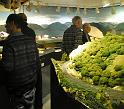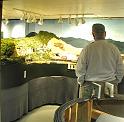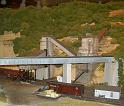Roger Sekera’s Clinch Valley Lines
by
Andrew Dodge
The
original inspiration Roger drew for his HO scale Clinch Valley Lines
(CVL) came from a photo taken in the fall of 1972 of a set of
Louisville and Nashville diesels heading-up a freight train on the
Norfolk and Western. Based on a freelanced prototype railroad and
set in 1959 Appalachia, Roger has developed an interesting layout
designed for operations that is fun to run and visually
appealing. Set in the southwestern area of Virginia, Roger draws
heavily upon the prototypes that run in that area, such as the N&W,
L&N, SRR, C&O and Clinchfield, to add realism to his layout.The
locomotives and rolling stock operating on the layout add to the air of
authenticity to the CVL by depicting the waning years of the transition
period. A 2-8-0 consolidation, which is used only in a motive
power emergency, stationed at the Andover yard is the only remaining
steam power on the layout. The CVL has a fleet of GP 7s, F units,
and other first-generation diesels to handle all freight and passenger
movements. Other roads also are represented on the layout such as
several Southern Railways RS 3s that have trackage rights on the
CVL. Roger has purchased his model locomotives from Life Like,
Atlas, and Kato because of their reliability. All of the rolling
stock reflects the pre-1959 time period including the remove of glad
hand air connectors from all rolling stock to better replicate the
era. Even the types of trains adhere to the period with an
emphasis on the movement of freight and the declining importance of
passenger service.Scheduled
freight service on Roger’s layout is evenly split between the movement
of coal and general merchandise with the center of operations in the
area around Bluefield, West Virginia, and Big Stone Gap,
Virginia. The subdivision yards at Andover features the most
interesting operational portion of the layout with a classification
yard and scales for weighing cars for proper billing to the
shipper. The branch going to the town of St. Paul also
supplements operational interests to the layout with the addition of a
number of different industrial sidings that require the railroad to
service with box and refrigerator cars. One of the most usual
industries on the layout is the Roberts Burlap mill in Wise, Virginia,
which produces finished burlap used, even today, in coal mines for
airflow control. To aid the movement of trains during operating
sessions, Roger has constructed two large staging yards at both ends of
the layout to represent “off the layout” destinations. Roger
likes to operate his layout with Railcommand controls and is a member
of an operating group that meets at different member’s layouts several
times a year. The CVL was part of ProRail 2010 and was featured
in the January 2012 Dispatchers Office magazine. The CVL has been
running for more than five years and has been operated almost 20 times
during that period. Under Steve King’s guidance, the CVL has
instituted Time Table Train Order or TTTO with 12 trains on the
timetable and additional six to seven extras run during an operational
session. In an additional effort to achieve prototype realism,
Roger creates all his car movement cards and waybills on a 1950s
vintage mechanical typewriter, which was on display during the open
house. In an additional effort to reflect the pace of railroading
during the period, all turnouts are hand thrown. The pace of
operations is purposely slowed to reflect the period and the lack of
competition. The
layout proved to be a big draw for Potomac Division modelers.
Despite the good weather and the draw to do outdoorsy things, 42
members, wives, and relatives came to visit. Everyone had a good
time and shared in the fellowship of model railroading. 










































